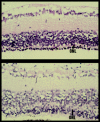An immune response after intraocular administration of an adenoviral vector containing a beta galactosidase reporter gene slows retinal degeneration in the rd mouse
- PMID: 11222343
- PMCID: PMC1723879
- DOI: 10.1136/bjo.85.3.341
An immune response after intraocular administration of an adenoviral vector containing a beta galactosidase reporter gene slows retinal degeneration in the rd mouse
Abstract
Background/aims: Retinal degenerations are a leading cause of blindness for which there are currently no effective treatments. This has stimulated interest in the investigation of gene therapy strategies for these diseases in a variety of animal models. A number of attempts have been made to prevent photoreceptor loss in the rd mouse model of retinal degeneration using adenoviral vectors containing either a copy of the missing functional gene or a gene encoding either a neurotrophic factor or an antiapoptotic factor. The authors have previously demonstrated that intraocular administration of an adenoviral vector containing a beta galactosidase gene (AV.LacZ) results in an immune response to viral gene products and beta galactosidase. Here the effect of the immune response on retinal degeneration is examined.
Methods: Juvenile rd mice were injected intravitreally with AV.LacZ and a proportion were depleted of either CD4+ or CD8+ T cells or both. Control animals were injected with PBS. The mice were sacrificed 10 and 20 days post-injection and their eyes embedded in paraffin wax and sectioned.
Results: 10 days after intravitreal injection of AV.LacZ, the outer nuclear layer contains an average of 2.5 rows compared with 1.5 in PBS injected animals (p<0.005). The protective effect of AV.LacZ is negated by immune suppression and does not extend beyond 20 days.
Conclusion: An immune response to vector and transgene products is able to slow degeneration in the rd mouse. This phenomenon should be taken into account when analysing the degeneration in the rd mouse following gene transfer.
Figures



Comment in
-
Gene therapy in hereditary retinal degeneration and the tower of Babel.Br J Ophthalmol. 2001 Mar;85(3):255. doi: 10.1136/bjo.85.3.255. Br J Ophthalmol. 2001. PMID: 11222324 Free PMC article. No abstract available.
References
MeSH terms
Substances
LinkOut - more resources
Full Text Sources
Medical
Research Materials
Miscellaneous
